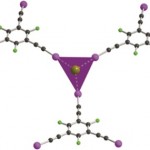
While an IUPAC definition of hydrogen bonding was only released in 2011 after decades of discussions in the scientific community, it did not take such a long time to come up with an analogous definition of halogen bonding, following a revival of this interaction in the literature which can be traced back to the early 1990s, Fourmigué, M. (2017). Acta Cryst. B73, 138-139
The halogen-bonding interaction is essentially described as an electrostatic interaction between a charge concentration (Lewis base) and a charge-depleted area, called an σ-hole, that a covalently bound halogen atom exhibits in the extension of this bond.
In a recent paper by Szell et al, (2017). Acta Cryst. B73, 153-162 single-crystal X-ray diffraction structures have been reported for a series of seven halogen-bonded co-crystals featuring 1,3,5-tris(iodoethynyl)-2,4,6-trifluorobenzene as the halogen-bond donor, and bromide ions (as ammonium or phosphonium salts) as the halogen-bond acceptors. Depending on the stoichiometry, the resulting frameworks can form honeycomb structures of variable geometry, but also systems with four or six halogen bonds to the bromide ion. While the counter-cations generally occupy the void spaces in the present work, the construction of halogen-bonded frameworks with potential gas storage applications is an appealing prospect which may be facilitated in the future by ligands enabling directional and multidentate interactions.